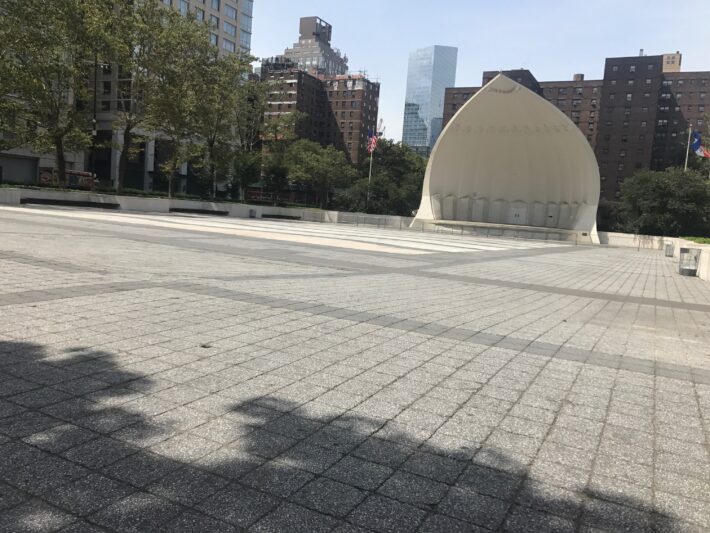
Moira Smith, a 60-year-old New Yorker with degenerative joint and autoimmune diseases, looked forward to a free outdoor Bonnie Raitt concert in mid-August – only to find, she said, that there were no accessible seats for someone who walks with a cane.
Damrosch Park is a 2.4-acre park on West 64th Street, south of the Metropolitan Opera House. Every summer for three weeks, the park attracts music and dance enthusiasts for the Lincoln Center Out of Doors festival, which for 47 years has provided free concerts, this year from July 26th to August 13th.
Smith had already attended five Out of Doors events this summer. She claims that the August 13th concert had the highest attendance and was the most difficult of the five to navigate, despite the fact that Damrosch Park is level and wheelchair accessible.
There were 300 folding chairs placed in rows in front of the stage, enclosed by metal gates, which prevented anyone else from getting into the seated area once all the seats were filled. Right behind the gates was a standing area, and people in wheelchairs were situated behind the standing onlookers.
When Smith approached the hospitality desk at an usher’s direction, she was told that there were no more accessible seats, leaving her to listen from afar, without being able to see the stage.
Lincoln Center CEO and President Debora Spar referred questions to Mary Caraccioli, chief communications officer, who said in an email, “For Out of Doors, there is accessible seating throughout the space to provide audience members with many locations from which to choose. All entrances and pathways are accessible, including the general line entrance and the accessible entrance.”
But the series are so popular that they often fill up quickly — as did the Raitt concert. “Out of Doors [concert] has limited seating,” said Caraccioli, “and once the seats are all taken we cannot promise a seat for anyone.”
Oliver Hoyt, an 18-year-old who has very limited speech and mobility capabilities, and uses a wheelchair, was seated behind the rest of the audience. His father, Arthur Hoyt, was outraged at the situation. “This is so unfair,” he says. “Oliver doesn’t get to go to concerts that much, and it’s not right that this is his experience at the one he actually gets to go to.” The Hoyts arrived an hour early but they were told the accessible seats were all already taken.
“There are requirements for the number of wheelchair-accessible spaces depending on the total number of seats in a venue,” says Rebecca C. Serbin, a staff attorney at the nonprofit Disability Rights Advocates (DRA), “and additional requirements for whether those seats have to be dispersed around the venue, and about the lines of sight for spectators watching from the wheelchair spaces vs. from elsewhere in the venue.”
According to Caraccioli, Lincoln Center was in full compliance of the law. “We comply with federal and New York City accessibility standards in determining the number of accessible seats in the venue,” she said.
Arthur Hoyt argues that the pathway to access the designated disability seating area was not visible on the night of August 13th. Smith says the situation depends on “how crowded [the event] is. The first two times, it was crowded, but not packed.”
“Our policies and procedures have been designed over several years, in close consultation with our industry peers and feedback from audience members attending Out of Doors. Providing the most equitable and accessible experience possible is a top priority. We are always open to ideas and input as to how we can better achieve this goal,” Miranda Appelbaum, Lincoln Center’s assistant director of accessibility and guest services, wrote in an email.
When asked what Lincoln Center can do better to make the seating process easier for people with disabilities, Smith answered, “They really need more designated seats for people with mobility issues. It really sends a mixed message when there aren’t any seats available for people with disabilities at events where music is supposed to bring people together.”